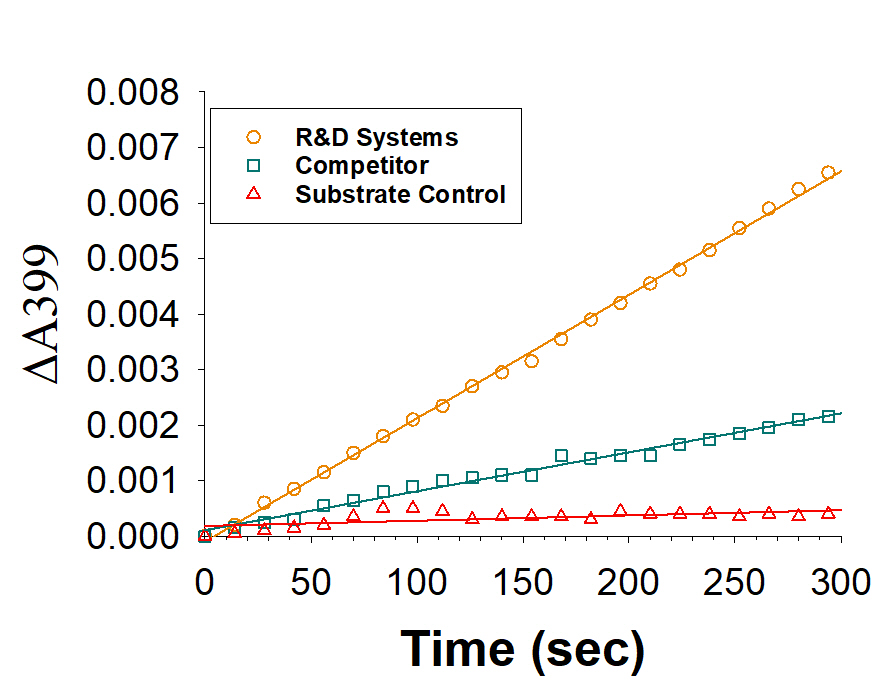Recombinant Human IMP Dehydrogenase 2/IMPDH2 Protein, CF
Recombinant Human IMP Dehydrogenase 2/IMPDH2 Protein, CF Summary
Product Specifications
Met1-Phe514, with a C-terminal 10-His tag
Analysis
Product Datasheets
Carrier Free
CF stands for Carrier Free (CF). We typically add Bovine Serum Albumin (BSA) as a carrier protein to our recombinant proteins. Adding a carrier protein enhances protein stability, increases shelf-life, and allows the recombinant protein to be stored at a more dilute concentration. The carrier free version does not contain BSA.
In general, we advise purchasing the recombinant protein with BSA for use in cell or tissue culture, or as an ELISA standard. In contrast, the carrier free protein is recommended for applications, in which the presence of BSA could interfere.
8349-DH
| Formulation | Supplied as a 0.2 μm filtered solution in Tris, NaCl, DTT and Glycerol. |
| Shipping | The product is shipped with dry ice or equivalent. Upon receipt, store it immediately at the temperature recommended below. |
| Stability & Storage: | Use a manual defrost freezer and avoid repeated freeze-thaw cycles.
|
Assay Procedure
- Assay Buffer: 50 mM Tris, 300 mM NaCl, 1 mM EDTA, 1 mM DTT, pH 8.0
- Recombinant Human Inosine 5'-Monophosphate Dehydrogenase 2/IMPDH2 (rhIMPDH2) (Catalog # 8349-DH)
- Nicotinamide adenine dinucleotide sodium salt ( beta -NAD) (Sigma, Catalog # N6522), 100 mM stock in deionized water
- Inosine 5'-monophosphate (IMP) (Sigma, Catalog # I4625), 100 mM stock in deionized water.
- UV plate (Costar, Catalog # 3635)
- Plate Reader (Model: SpectraMax Plus by Molecular Devices) or equivalent
- Dilute rhIMPDH2 to 20 μg/mL in Assay Buffer.
- Create Substrate Mixture containing 500 μM IMP and 1 mM beta -NAD in Assay Buffer.
- Load 50 μL of 20 μg/mL rhIMPDH-2 into a plate, and start the reaction by adding 50 μL of Substrate Mixture. For Substrate Blanks, load 50 μL of Assay Buffer and 50 μL of Substrate Mixture.
- Read plate at a wavelength of 339 nm (bottom read) in kinetic mode for 5 minutes.
- Calculate specific activity:
Specific Activity (pmol/min/µg) = | Adjusted Vmax* (OD/min) x well volume (L) x 1012 pmol/mol |
| ext. coeff** (M-1cm-1) x path corr.*** (cm) x amount of enzyme (µg) |
*Adjusted for Substrate Blank.
**Using the extinction coefficient 6220 M-1cm-1.
***Using the path correction 0.320 cm.
Note: the output of many spectrophotometers is in mOD.
- rhIMPDH-2: 1.0 μg
- beta -NAD: 500 μM
- IMP: 250 μM
Scientific Data
 View Larger
View Larger
Recombinant Human IMPDH2 (Catalog # 8349-DH) is measured by its ability to convert the substrate inosine-5'-phosphate (IMP) to xanthosine-5'-phosphate (XMP). The activity (orange) is approximately 3.5-fold greater than the competitor's IMPDH2 (green).
 View Larger
View Larger
1 μg/lane of Recombinant Human Inosine 5'-Monophosphate Dehydrogenase 2/IMPDH2 was resolved with SDS-PAGE under reducing (R) and non-reducing (NR) conditions and visualized by silverstaining, showing a band at 57 kDa.
Reconstitution Calculator
Background: IMP Dehydrogenase 2/IMPDH2
IMPDH2 (inosine monophosphate dehydrogenase) is one of two cytosolic and nuclear enzyme isoforms that play a central role in guanine nucleotide metabolism. The isoforms are 84% identical but distinctly regulated. While IMPDH1 is generally constitutively expressed, IMPDH2 is inducible during proliferation and transformation (1, 2). Both isoforms form a homotetramer of approximately 55 kDa monomers containing a catalytic barrel domain and a subdomain with two cystathione beta-synthase domains which mediate RNA and DNA binding (1, 3). Both enzymes catalyze the NAD-dependent conversion of inosine monophosphate (IMP) to hypoxanthine monophosphate (XMP) which is a precursor for the synthesis of GMP, guanosine, and guanine. These compounds are critical for DNA synthesis and cell proliferation (4, 5) which explains the importance of IMPDH in cancer and viral infection (6-9). Although IMPDH1 and IMPDH2 are known to be inhibited by the immunosuppressant drug mycophenolic acid (MPA), much research has targeted discovery of additional and selective inhibitors for IMPDH isoforms given they are targets for several major therapeutic areas (1, 9-13). Human IMPDH2 shares 99% amino acid sequence identity with mouse IMPDH2.
- Hedstrom, L. (2009) Chem. Rev. 109:2903.
- Thomas, E.C. et al. (2012) PLoS One 12:e51096.
- McLean, J.E. et al. (2004) Biochem. J. 379:243.
- Lane, A.N. and T.W. Fan (2015) Nucleic Acids Res. 43:2466.
- Jackson, R.C. et al. (1975) Nature 256:331.
- Zho, J. et al. (2015) Med. Oncol. 32:373.
- Xu, Y. et al. (2017) Sci. Rep. 7:745.
- Nair, V. (2007) Antivir. Chem. Chemother. 18:245.
- Trapero, A. et al. (2018) J. Med. Chem. 61:2806.
- Barnes, B.J. et al. (2001) Int. J. Cancer 94:275.
- Cholewinksi, G. et al. (2015) J. Enzyme Inhib. Med. Chem. 30:550.
- Liao, L.X. et al. (2017) Proc. Natl. Acad. Sci. USA 114:E5986.
- Cuny, G.D. et al. (2017) Expert Opin. Ther. Pat. 27:677.
FAQs
No product specific FAQs exist for this product, however you may
View all Proteins and Enzyme FAQsReviews for Recombinant Human IMP Dehydrogenase 2/IMPDH2 Protein, CF
There are currently no reviews for this product. Be the first to review Recombinant Human IMP Dehydrogenase 2/IMPDH2 Protein, CF and earn rewards!
Have you used Recombinant Human IMP Dehydrogenase 2/IMPDH2 Protein, CF?
Submit a review and receive an Amazon gift card.
$25/€18/£15/$25CAN/¥75 Yuan/¥2500 Yen for a review with an image
$10/€7/£6/$10 CAD/¥70 Yuan/¥1110 Yen for a review without an image
